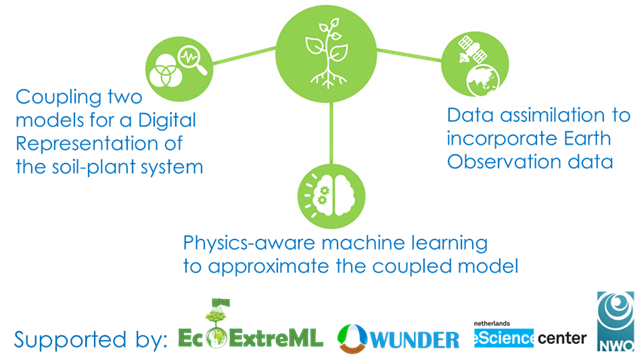Open Digital Twin of Soil-Plant System
Soil is one of the most critical life-supporting compartments of the biosphere, that provides us with numerous ecosystem services with food, biomass and fibers, and raw materials. Soil regulates the water, carbon, and nutrient cycles, provides a habitat for biodiversity, and makes life on land possible. Despite the many important functions of soil, it’s been estimated that about 60 to 70% of soils in the EU are not healthy, and many fundamental knowledge gaps remain.
The new EU soil strategy for 2030 intends to address land degradation comprehensively, aiming to achieve all EU soil ecosystems in a healthy condition by 2050. This strategy closely relates to climate mitigation, circular economy, biodiversity, desertification, soil restoration, soil monitoring, and citizen engagement to enable the transition to healthy soil. The core of the strategy is the concept of soil health, the quantification of which needs to be substantiated by measurable indicators based on hard facts and data.
Soil health indicators include organic matter (e.g., soil organic matter/carbon content, easily degradable organic matter, etc.), physical properties (e.g., water holding capacity, aggregate stability, dry bulk density, etc.), chemical parameters (e.g., pH, total nitrogen, potentially mineralizable nitrogen, total soil phosphate/potassium stock and availability, etc.), and biodiversity (e.g., nematodes, bacterial/fungal biomass, Earthworms, etc.). It is, however, well aware that not all these soil health indicators can be obtained from in-situ monitoring and soil sampling (at point scales). Particularly, when we need to evaluate the soil health of a certain region (or the globe) in a spatial context, we will need spatiotemporally continuous soil health indicators. For this purpose, we must combine medium-resolution Copernicus satellite data with high-resolution unmanned aerial system (UAS) data, in situ observations, process-based models, machine learning algorithms, and data assimilation for big-data analytics. And this approach is actually calling for a soil-plant digital twin.
To address the above challenge, Dr. Yijian Zeng has been focusing on developing an "Open Digital Twin of Soil-Plant System," which includes three core components.
- The soil-plant model for a digital representation of the soil-plant system;
- Physics-aware machine learning algorithms to approximate the soil-plant model; and
- Data assimilation framework to digest Earth Observation data to update the states of soil-plant system.

See Dr. Zeng’s webpage for more information.
Dr. Yijian Zeng is currently working on two projects to develop the soil-plant digital twin for monitoring and predicting soil health:
- CO-I: WUNDER: Water Use and Drought Ecohydrological Responses of Agricultural and Nature Ecosystems in the Netherlands: Towards Climate-Robust Production Systems and Water Management (2022-2028, €1,516,238)
- PI: EcoExtreML: Accelerating Process Understanding for Ecosystem Functioning under Extreme Climates with Physics-Aware Machine Learning (2021-2024, €253,000 + 3 Person-Year (PYR) Research Software Engineers (RSE) from NLeScience Center, 1.0 PYR represents 1,536 hours of RSE time)


